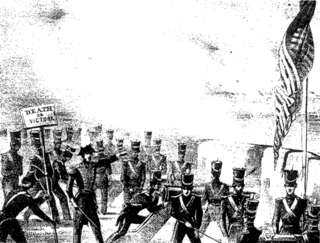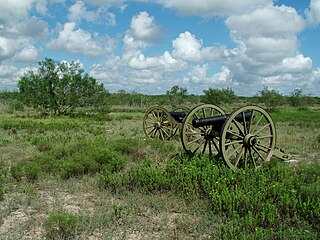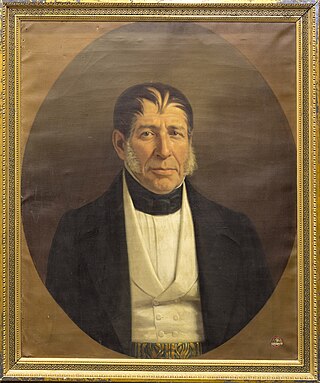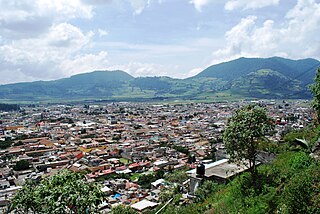
The Battle of Palo Alto was the first major battle of the Mexican–American War and was fought on May 8, 1846, on disputed ground five miles (8 km) from the modern-day city of Brownsville, Texas. A force of some 3,700 Mexican troops – most of the Army of The North – led by General Mariano Arista engaged a force of approximately 2,300 United States troops – the Army of Occupation led by General Zachary Taylor.

The Battle of Resaca de la Palma was one of the early engagements of the Mexican–American War, where the United States Army under General Zachary Taylor engaged the retreating forces of the Mexican Ejército del Norte under General Mariano Arista on May 9, 1846. The United States emerged victorious and forced the Mexicans out of Texas.

The Thornton Affair, also known as the Thornton Skirmish, Thornton's Defeat, or Rancho Carricitos, was a battle in 1846 between the military forces of the United States and Mexico 20 miles (32 km) west upriver from Zachary Taylor's camp along the Rio Grande. The much larger Mexican force defeated the Americans in the opening of hostilities, and was the primary justification for U.S. President James K. Polk's call to Congress to declare war.

The siege of Fort Texas marked the beginning of active campaigning by the armies of the United States and Mexico during the Mexican–American War. The battle is sometimes called the siege of Fort Brown. Major Jacob Brown, not to be confused with War of 1812 General Jacob Brown, was one of the two Americans killed in action.

José Mariano Arista was a Mexican soldier and politician who also became president of Mexico.

Pedro Nolasco Martín José María de la Candelaria Francisco Javier Ampudia y Grimarest was born in Havana, Cuba, and served Mexico as a Northern army officer for most of his life. At various points he was the governor of Tabasco, Yucatán, and Nuevo León. He also served a short term as Secretary of National Defense under President Benito Juárez.

Tlaxcala is a state in Central Mexico that is divided into 60 municipalities. According to the 2020 Mexican census, it is the fifth least populated state with 1,342,977 inhabitants and the 2nd smallest by land area spanning 3,996.6 square kilometres (1,543.1 sq mi).

Palo Alto Battlefield National Historical Park near Brownsville, Texas, United States, is a National Park Service unit which preserves the grounds of the May 8, 1846, Battle of Palo Alto. It was the first major conflict in a border dispute that soon precipitated the Mexican–American War. The United States Army victory here made the invasion of Mexico possible. The historic site portrays the battle and the war, and its causes and consequences, from the perspectives of both the United States and Mexico.

Juan Bautista Loreto Mucio Francisco José de Asís de la Santísima Trinidad Ceballos Gómez Sañudo (1811-1859) was a Mexican politician who served in congress and in the supreme court before being briefly made president after the resignation of President Mariano Arista during a revolution known as the Plan of Jalisco in 1853. He failed to come to any sort of arrangements with the insurgents and resigned after only about a month of serving and went back to his seat on the supreme court. After being removed from the court by the restored Santa Anna, he left the country and died in Paris in 1859.

José Joaquín Antonio Florencio de Herrera y Ricardos was a Mexican statesman who served as president of Mexico three times, and as a general in the Mexican Army during the Mexican–American War of 1846–1848.

The Republic of the Rio Grande was one of a series of political movements in Mexico which sought to become independent from the unitary government dominated by Antonio López de Santa Anna; the Republic of Texas and the second Republic of Yucatán were created by political movements that pursued the same goal. Insurgents fighting against the Centralist Republic of Mexico sought to establish the Republic of the Rio Grande as an independent nation in Northern Mexico. The rebellion lasted from 17 January to 6 November 1840.
Jean-Louis Berlandier was a French-Mexican naturalist, physician, and anthropologist.

Carnitas, literally meaning "little meats", in Mexican cuisine, is a dish made by braising, simmering and frying pork in its own fat, lard or cooking oil. The name “Carnitas” is, historically, the vulgar, colloquial name given in Mexico for the French dish Rillons de Tours also known in Spanish as Chicharrón de Tours.

The flag of the Republic of the Rio Grande was used in 1840, during 283 days from January 17 to November 6, as long as the republic existed. This country was formed by the northeastern Mexican states of Coahuila, Nuevo León, and Tamaulipas. The flag was no longer used following the defeat of the Republic of the Rio Grande by Mexican troops.

Guillermo Prieto Pradillo was a Mexican novelist, short-story writer, poet, chronicler, journalist, essayist, patriot and Liberal politician. According to Eladio Cortés, during his lifetime he was considered Mexico's national poet, and his political allegiance to the Mexican liberals allowed him to serve as Minister of Finance and Foreign Affairs under different administrations.

The municipality of Tenango del Valle is located in the southern portion of the Valley of Toluca in Mexico State, about 72 km southwest of Mexico City and 25 km south of Toluca. The municipal seat is the city of Tenango de Arista. While the seat is officially named Tenango de Arista, it is more commonly referred to as Tenango del Valle, as this was the original name of the town. Tenango del Valle is best known as the site of the Teotenango archeological site, which was a walled city inhabited from about 900 C.E. to 1550 C.E.

Puerto Arista is a small community and tourist attraction located on the north coast of Chiapas, Mexico in the municipality of Tonalá. While it originally was a port, its lack of harbor and suitability for large cargo ships eventually shifted the economy to tourism in the 20th century. It is popular with people from Chiapas as it is located close to the state capital of Tuxtla Gutiérrez as well as the regional city of Tonalá. It is the most visited beach in Chiapas and one of its most popular tourist destinations, despite its relative lack of sophisticated tourism infrastructure. Puerto Arista is home of one of the state’s four marine turtle sanctuaries, design to help protect the various species which come here to lay their eggs.

The Texas Campaign was the first front in the Mexican–American War, fought between the United States and Mexico. The front started with a Mexican assault near Brownsville. US forces were forced to surrender after hours of resisting, which led President James K. Polk to declare war on Mexico. After the United States defeated a larger Mexican Army at Palo Alto and Resaca de la Palma, Mexican Forces led by Mariano Arista retreated out of Texas.
















